Great
AMERICAN Pyramids
Mention the word Pyramid to anyone and it is normal to think of the famous
Egyptian pyramids at
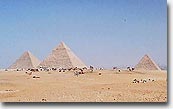 Giza, where the pyramid of Cheops build around 2,480BC is said to encompass all sorts of fabulous properties such as the ratio of the mathematical constant pi, dimensions relative to the size of the Earth, it's weight and distance from the sun etc as well as a "sacred" system of cubits derived from the size of the Earth. When Napoleon took his army on a conquest of Egypt, he brought with him a team of Savants to prise open the lost secrets of the "great" pyramid.
Giza, where the pyramid of Cheops build around 2,480BC is said to encompass all sorts of fabulous properties such as the ratio of the mathematical constant pi, dimensions relative to the size of the Earth, it's weight and distance from the sun etc as well as a "sacred" system of cubits derived from the size of the Earth. When Napoleon took his army on a conquest of Egypt, he brought with him a team of Savants to prise open the lost secrets of the "great" pyramid.
With a base side of 756 feet or 440 Egyptian cubits, it is a well engineered and impressive monument, awesome in it's construction and general size. Egypt is sometimes thought of as "the land of the pyramids", but there is another land of the pyramids - America
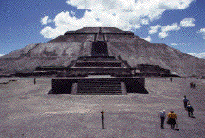
Here is a little known fact. The pyramid known as "the Sun Pyramid" at
Teotihuacan in the heart of Mexico has a base side of 738 feet -
almost identical to the base of the Great pyramid in Egypt and only 18
feet shorter per side! It is sometimes called "the City of the Gods," or "where men ascended and became Gods". Little is known about
the fabulous city of Teotihuacan except that it was constructed around
AD100 - 200. In it's day it was the sixth largest city in the world
with a population of 60-80,000 people occupying an area of 20sq kms.
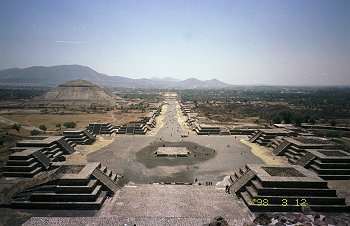
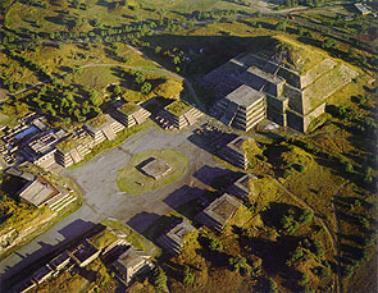
A long avenue leads to the "Pyramid of the Moon" and it is sometime thought that this avenue might have been filled with water to make a sort of canal or waterway approaching the pyramid.
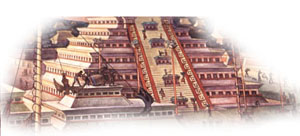
Not far from Teotihuacan in the valley of Mexico lies another more
famous city - Tenochitlan,
the Aztec city sacked by Cortes who attempted to carry off it's
treasures and returned later to raze it to the ground, constructing
Mexico City out of it's ruins. Tenochtitlan was built on an island
in a lake and had it's fair share of pyramids - some of which were used
for gruesome sacrifices where it is said that as much as 20,000 victims
were killed to appease the gods in a single day.
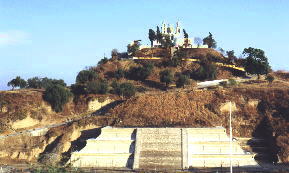 At
Cholula, in Mexico is said to be the largest pyramid in the world, the Tepanapa, like a giant hill with a church on top.
Until 1910, nobody knew it was a pyramid. Almost certainly it was already a tree-covered hill at the time of the conquest. Archaeologists say it was contemporary with the great Pyramids of the Sun and the Moon at Teotihuacan. If so, it would have been in use a thousand years before the time of these events, and could have been covered and forgotten.
At
Cholula, in Mexico is said to be the largest pyramid in the world, the Tepanapa, like a giant hill with a church on top.
Until 1910, nobody knew it was a pyramid. Almost certainly it was already a tree-covered hill at the time of the conquest. Archaeologists say it was contemporary with the great Pyramids of the Sun and the Moon at Teotihuacan. If so, it would have been in use a thousand years before the time of these events, and could have been covered and forgotten.
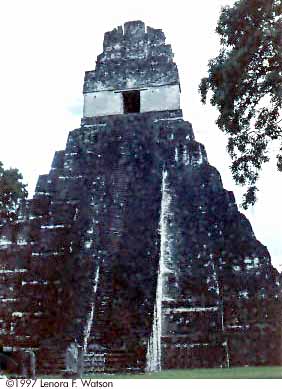
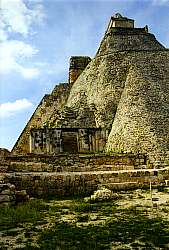

Throughout the whole of Yukatan, lie the impressive remains of the Mayan civilisations, with countless pyramids such as those at
Palenque, or at
Uxmal or Chitzen Itza where is to be found the Temple of Kukulcan, sometimes called "el Castillo".
This magical monument at a certain time of year casts a shadow in such a way that a giant snake is seen to be descending down the staircase in honour of the god, Quetzelcoatl.
North America is home to numerous pyramids in the form of mounds of earth in varios formations such as that at
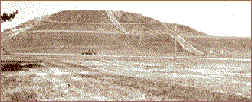 Monk's Mound
which
covers 16 acres; it rests on a base 1,037 feet long and 790 feet wide, with a total volume of approximately 21,690,000 cubic feet, a base and total volume greater than that of the pyramid of Khufu, the largest in Egypt.
Monk's Mound
which
covers 16 acres; it rests on a base 1,037 feet long and 790 feet wide, with a total volume of approximately 21,690,000 cubic feet, a base and total volume greater than that of the pyramid of Khufu, the largest in Egypt.
But when we turn to South America, the pyramids get bigger, bolder, and older.
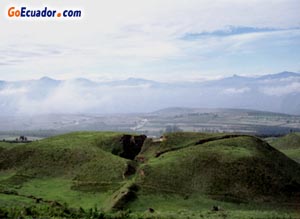 At Cochasqui
in Eguador there is a litle known pyramid complex linked to astronomical alignments
At Cochasqui
in Eguador there is a litle known pyramid complex linked to astronomical alignments
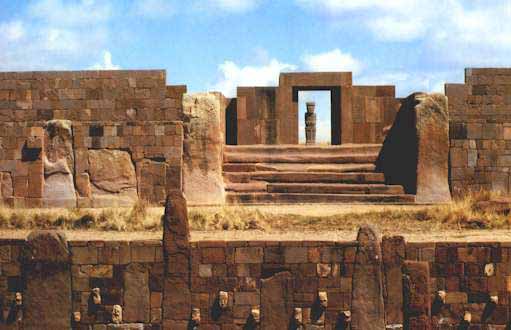
Tiahuanaco, until recently considered the oldest city in the Americas has the largely un-excavated Akapana pyramid with internal water channels, sometimes said to be a site for refining tin.
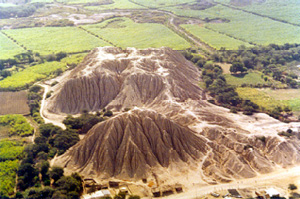
The city of Chan Chan on the Peruvian coast had a giant adobe pyramid which the Spanish engineers diverted a river to so they could wash its bulk away in their search for some hidden treasure.
The North of Peru is rich of interesting places like Trujillo, Chiclayo and the lost world of the Chachapoyas.
The Pre-Columbian Chachapoyas culture, conquered in the 15th century by the Incas, has left a landscape scattered with villages and burial sites which until recently has been largely overlooked by archaeologists. Situated in the cloud forests around the town of Chachapoyas in Peru’s northern Amazonas Department, these sites are dominated by the mighty fortress of Kuelap, perched majestically atop mountain-top cliffs overlooking the verdant Andean landscape. In Chachapoyas, remnants of the past invite discovery by the bold adventurer, and the cultures of the present extend a friendly welcome.
In Chiclayo lies the tomb of the Lord of Sipan (the richest tomb discovered in the Americas), the Valley of the 26 pyramids of Tucume and Bruning Museum where there is an interesting collection of gold artifacts and ceramics
The pyramids of the Sun and Moon, just south of Trujillo, are the largest structures ever put up in South America, and are second in the Western Hemisphere only to the Pyramid of Cholula, Mexico, in size. They formed the spiritual center of the Moche Empire, a highly sophisticated yet mysterious culture that pre-dated the Incas by nearly 1000 years. It is quite certain that the Moche Indians had contact with other civilizations in the ancient Americas, and there is good reason to believe they may have been influenced by Asian ocean- going voyagers as well. The Pyramid of the Moon contains a central, vaulted chamber, and the mountain directly behind, Cerro Blanco, appears to have been shaped by humans into a pyramid form as well. Huanchaco is a fishing town where “caballitos de totoro” are still used by the local inhabitants, who venture into the cold currents of the Pacific in these precarious-looking reed boats. This massive adobe city, really a series of royal compounds built by the Chimu, was a major source of gold for both the Incas, and later, for the Spanish. Though well-looted over the centuries, gold artifacts still occasionally appear in the drifting sands. Contacts between Chan Chan and the Asian continent have never been proven, but there are tantalizing hints. Pottery figures depict Asiatic men with beards and turbans; even the name “Chan Chan” seems to be Chinese in origin.
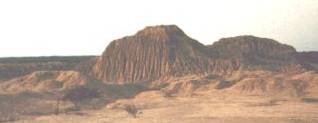
At Tucume,
again in Peru, Thor Heyerdahl found the pyramids to be so massive
that at first they were thought to be natural mountains.
The largest of these measuring some 1,476 x 328 x 131ft is
rectangular in shape with it's longest side almost double that
of the Great Pyramid in Egypt.
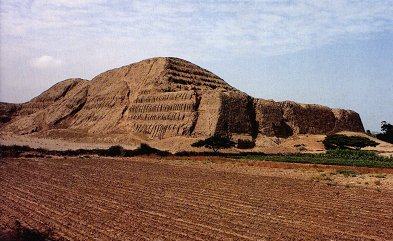
At Trujillo in Peru, the Pyramids of the Sun and the Moon date from the Moche period of around 600AD and used 140 million adobe bricks in their construction.
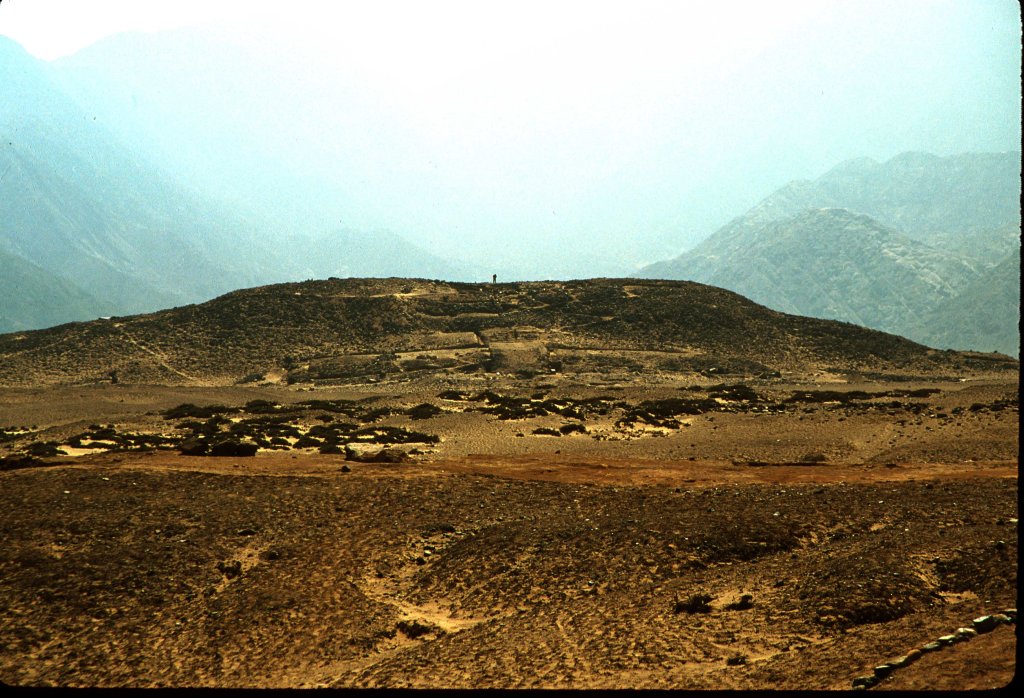
And the latest site discovered, again in Peru in the Supe valley is at Caral where the pyramids are said to date to 2627BC - making them older than the first Egyptian pyramids.
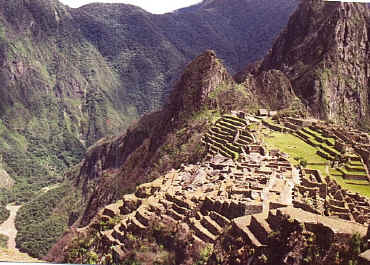
At the well known site of
Machu Picchu - said
to be the last stronghold of the Inca and built on a sheer mountain top,
the casual visitor is probably unaware that the valley below along the edge
of the Vilcobamba River contains a giant flat topped pyramid, engineered
so that it is only visible at certain times of the year.
This kind of sacred engineering seems to have been a feature of ancient
American cultures.
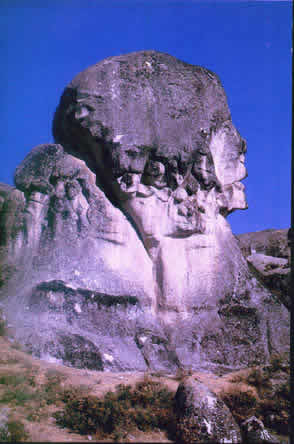 On the Marcahuasi plateau in Peru, there exist numerous giant sculptures including a Sphinz-like head, but these features can only be seen properly from a key vantage point.
On the Marcahuasi plateau in Peru, there exist numerous giant sculptures including a Sphinz-like head, but these features can only be seen properly from a key vantage point.

In Bolivia, not far from the petrified or enchanted city of Pumiri, is to be seen a "Cheops"-like pyramid in the distance, but closer inspection at any other angle suggests it is a natural mountain. Similarly at a remote site in the village of St Bartolome on the Bolivian Altiplano, a part of a pyramid is seen to be propped up against a natural rock face.
In ancient South America it would seem, natural features sometimes look man-made and man-made features look natural, why build a whole pyramid when from where you are standing the landscape can be improved by building or improving a site to give the appearance of a pyramid in the distance!
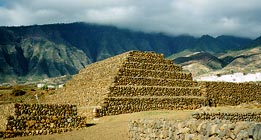
Reaching across the Atlantic to the Canary islands, step pyramids are also to be found on the island of Tenerife where the complex known as the Pyramids of Guimar have been investigated by Thor Heyerdahl. Did ancient explorers from the Americas stop this way on their way to the Mediterranean? These are flat-topped pyramids in the American style since the majority of American pyramids were flat-topped stepped platforms often with a small temple on the top, not unlike the ziggurats of Mesopotamia, but Egyptian pyramids, with the exception of the stepped pyramid at Saqarra which is one of the earliest ones, were largely smooth faced and sharply pointed.
J.M.Allen 14th November 2002
Teotihuacan location 19º 42´N 98º 50´W
Tenochitlan 19º 50´N 96º 54´W
Chitzen Itza (Temple of Kukulcan -el Castillo)20º 40´N 88º 34´W
Tula 20º 03´N 99º 20´W
Uxmal 20º 21´N 89º 47´W
Tiwanaku 18º 34´S 6840´W
Tucume 6º 30S´ 79º 51´W
ChanChan 8º 07´S 79º 03´W
Trujillo 8º 07´S 79º 02´W
Caral 10º 54´S 77º 31´W
Marcahuasi 11º 46´S 76º 34´W
Nazca 14º 42´S 75º 06´W
 Giza, where the pyramid of Cheops build around 2,480BC is said to encompass all sorts of fabulous properties such as the ratio of the mathematical constant pi, dimensions relative to the size of the Earth, it's weight and distance from the sun etc as well as a "sacred" system of cubits derived from the size of the Earth. When Napoleon took his army on a conquest of Egypt, he brought with him a team of Savants to prise open the lost secrets of the "great" pyramid.
Giza, where the pyramid of Cheops build around 2,480BC is said to encompass all sorts of fabulous properties such as the ratio of the mathematical constant pi, dimensions relative to the size of the Earth, it's weight and distance from the sun etc as well as a "sacred" system of cubits derived from the size of the Earth. When Napoleon took his army on a conquest of Egypt, he brought with him a team of Savants to prise open the lost secrets of the "great" pyramid.








 At Cochasqui
At Cochasqui 







